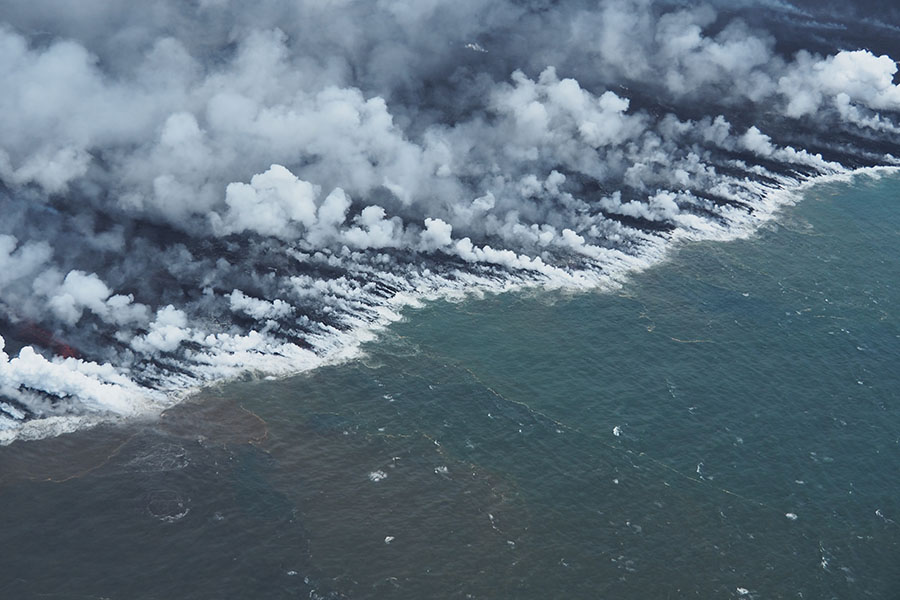
When Kīlauea Volcano erupted in 2018, it injected millions of cubic feet of molten lava into the nutrient-poor waters off the Big Island of Hawai‘i. The lava-impacted seawater contained high concentrations of nutrients that stimulated phytoplankton growth, resulting in an extensive plume of microbes that was detectable by satellite.
A Florida State University researcher was part of a multiuniversity research team that revealed that this biological response hinged on unexpectedly high concentrations of nitrate, despite the negligible amount of nitrogen in basaltic lava. The research team determined that nitrate was brought to the surface ocean when heat from the substantial input of lava into the ocean warmed nutrient-rich deep waters and caused them to rise up, supplying the sunlit layer with nutrients.
Their work was published in Science.
“This is a previously unrecognized process that supplies nutrients to phytoplankton in the ocean,” said Florida State University Associate Professor Angela Knapp, a member of the research team. “Phytoplankton play a role in regulating atmospheric CO2 concentrations. Consequently, their growth helps regulate climate.”
After observing the phytoplankton bloom in satellite images, the University of Hawaii Mānoa Center for Microbial Oceanography: Research and Education (C-MORE) organized a rapid response oceanographic expedition on UH research vessel Ka‘imikai-O-Kanaloa from July 13- 17, 2018 — in the thick of Kilauea’s activity. The team conducted round-the-clock operations in the vicinity of the lava entry region to test water chemistry and the biological response to the dramatic event.
“The expedition in July 2018 provided a unique opportunity to see first-hand how a massive input of external nutrients alters marine ecosystems that are finely attuned to low-nutrient conditions,” said Sam Wilson, an assistant researcher at University of Hawaii and the co-lead author on the study. “Ecosystem responses to such a substantial addition of nutrients are rarely observed or sampled in real time.”
Wilson and co-lead author Nick Hawco, a University of Southern California researcher who will be joining the UH Mānoa Oceanography Department in January 2020, tested the hypothesis that lava and volcanic dust would stimulate microorganisms that are limited by phosphate or iron, which are chemicals found in lava.
They also recruited Knapp from FSU’s Department of Earth, Ocean, and Atmospheric Science for her expertise in the marine nitrogen cycle.
Knapp’s team measured the isotopic composition of nitrate in the seawater samples collected by the UH team. She used the isotopic composition of the nitrate as a geochemical signature to help identify where the elevated concentrations of nitrate observed in the samples were coming from, since nitrate is not a typical byproduct of lava.
Phytoplankton growing near Hawaii are often limited by the scarcity of iron and nitrate in surface waters. Unsurprisingly, the lava supplied iron in abundance, alleviating that need. However, phytoplankton will not bloom if they are only supplied with iron – they need nitrate to grow, as well. What was not expected were the elevated concentrations of nitrate observed in surface waters impacted by the lava. Knapp’s interpretation of the oceanwater samples helped researchers conclude that deep, heated seawater became buoyant and brought up nitrate from the depths, causing phytoplankton to bloom in surface waters.
It is possible that this mechanism has led to similar ocean fertilization events in the past associated with the formation of the Hawaiian Islands and other significant volcanic eruptions, the authors suggest. Depending on their location, sustained eruption on this scale could also facilitate a large flux of nitrate from the deep ocean and perturb larger scale ocean circulation, biology and chemistry.
“No one has ever documented this phenomenon before,” Knapp said. “This could be a missing piece of understanding past climate changes throughout history.”




